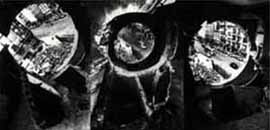negative spaces |
|
|
Negative spaces

The cut houses of Matta-Clark emphasize the precarious and desegregated character of the
urban landscape. They create critical spaces where the different plans, vertical and
horizontal, confuse, continuously modifying the perception of the observer. A negative
architectural activity: to cut, to excavate, and to deconstruct. To detect
voids, existing
holes in the city, spaces that had remained - they allow to review or to disintegrate the
urban and architectural syntax. To tear up architecture, displaying its secret
functioning. To exhume foundations, to cut ceilings, walls and floors, demanding to the
observer a vertiginous work, balancing at the border of abysses.
The inserted cuts in the constructions, these negative spaces, provoke a percipient nondifferentiation, a blanking of the difference between horizontal and vertical plans. Dissections that breaches the unit and continuity associate to architecture, to make visible multiple and unexpected space and time layers. These openings, crossing the building as a periscope, show the destruction of all real continuity between the historical city and the new constructions, the rupture of the apparently homogeneous urban fabric. Emphasizing abrupt adjacencies, they disclose the undo links and proximities between the places.
Incisions that allow to go beyond what can be seen, the different crossed things. Probes bringing social information hidden under the surface. A creation of "ruins", disclosing other layers of architectural and anthropological meanings, socially hidden. They evidence other ways to conceive the property, the public and the private. The cut house points to the layers of past references inscribed in the constructions and, at the same time, to the disjunctions in the functioning of the city and society. These cuts evidence the power of the absent, of the emptiness.
Matta-Clark would buy batches in these areas _ displaying property documents, photos and maps _ to assign spaces that certainly could not be seen and would not be occupied. Invisible not such because inaccessible, but because they don’t have any utility, just a nominal value. Index of the entropy incidence in the urban environment.
Reference:
R. Deutsche, Evictions, MIT, Cambridge, 1996.
Images:
G.Matta-Clark, conical intersect, 1975; G. Matta-Clark, splitting, 1974
